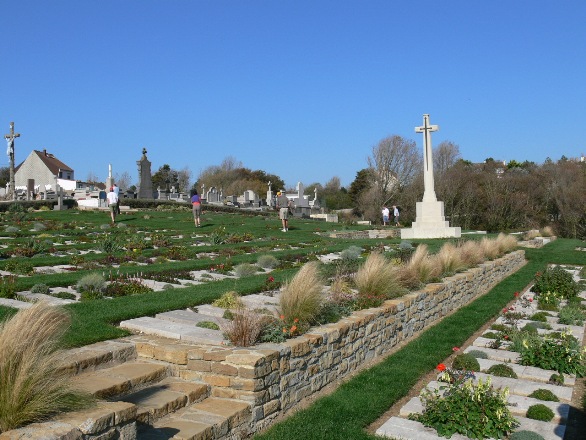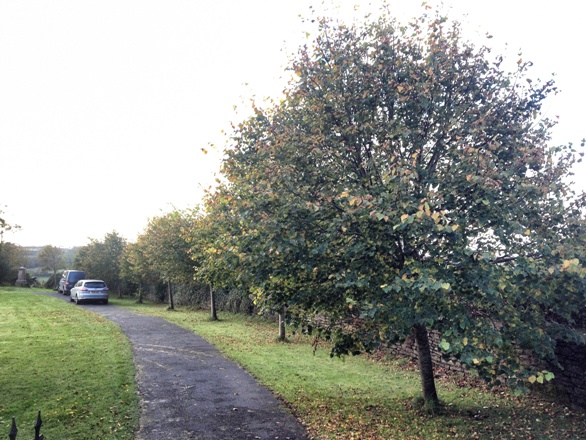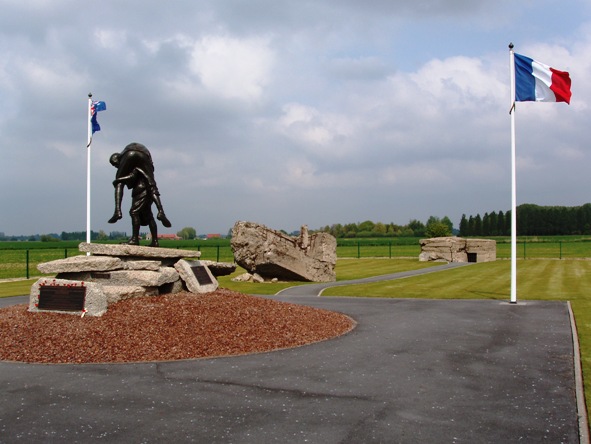Posts Tagged ‘Fromelles’
Private William Fry, 53rd Battalion AIF at Fromelles for BBC Wales ‘Coming Home’ with Robert Glenister
In October I was approached by Yellow Duck Productions to help with an episode of their BBC Wales series ‘Coming Home’. I was to conduct research into the wartime service of William Fry, a miner from Penclawdd in the north of the Gower Peninsula outside Swansea. William Fry was a relative of Spooks and Hustle actor Robert Glenister.
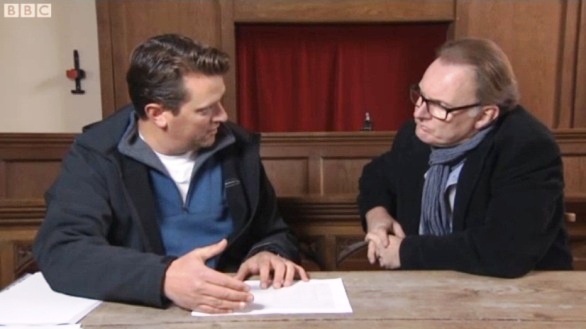
Talking through William Fry's wartime service with Robert Glenister in St Gwynour's Church, Penclawdd
William Fry left Wales in 1914, en route to a new life in Australia. At sea when war was declared, he arrived in Sydney in late August 1914. By the end of July 1915 William had enlisted in the Australian Imperial Force and sailed from Sydney on 8 October 1915 bound for Egypt. Whilst at Tel el-Kebir in February 1916 he transferred to the 53rd Battalion, a strange mix of Gallipoli veterans from the 1st Battalion and new, inexperienced reinforcements from Australia. The battalion, along with the 54th, 55th and 56th formed the 14th Infantry Brigade, part of the Fifth Australian Division.
The battalion arrived in Marseille at the end of June and after a journey north through France entered front line trenches opposite Fromelles on 10 July. It was customary practice to provide new units with time to ‘bed in’ in a quiet, nursery sector in order to get used to the routines and peculiarities of trench life. No such luxury was afforded William’s 53rd Battalion as, within a week, they were selected to be at the vanguard of a strong attack against German trenches at Fromelles. After a day’s rest in billets the 53rd Battalion were back in the front line on 17 July.
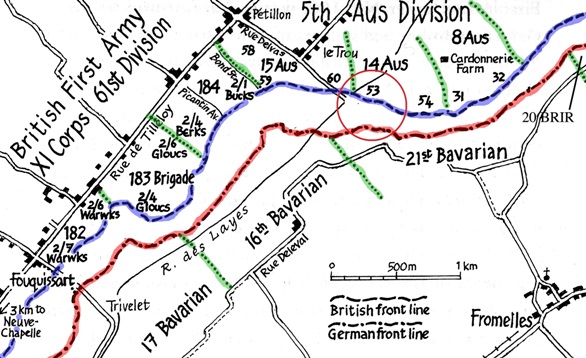
Map showing frontage for the Fromelles attack. The position of William Fry’s 53rd Battalion AIF is circled.
The plan required an initial softening of German defences by artillery bombardment and the attacking infantry to advance at 1800hrs in broad daylight, capturing and seizing two lines of trenches. At 1743hrs the first wave moved out into No Man’s Land, followed 100 yards later by the next wave. At Zero Hour (1800hrs) the Battalion charged and captured the first two lines of trenches as planned but then, contrary to the agreed plan, pushed on ‘200 yds further to hold back enemy’s bomber who were counter-attacking’.
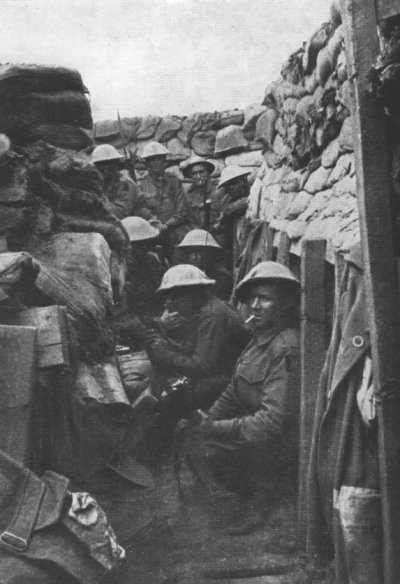
Members of William Fry’s 53rd Battalion prior to ‘hopping the bags’ on 19 July 1916. Reproduced courtesy Australian War Memorial (ID Number A03042).
The positions were held through the night but determined German counter attacks coupled with an exposed right flank forced the 53rd back across No Man’s Land to their starting position at 0930hrs on the 20th. Casualties for the operation totalled 625, an extraordinarily high figure which included the commanding officer. The attack at Fromelles was a complete disaster; losses for the Fifth Australian Division were over 5500 men. At some point on the 19th July William Fry was badly wounded; his medical records show he received GSW (Gun Shot Wounds) to both legs. He was evacuated along the casualty clearance chain, ending up at No.14 General Hospital at Wimereux on the channel coast. Sadly, William Fry died of his wounds at 4.15pm on 26 July 1916 and is buried at Wimereux Communal Cemetery.
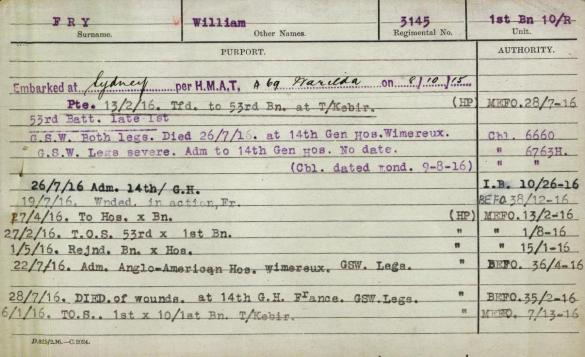
Extract from William Fry’s service record showing his movements from leaving Sydney in October 1915 to his wounding on 19 July and death at No.14 General Hospital, Wimereux.
Prior to the day’s filming at St Gwynour’s Church in Penclawdd Robert was completely unaware of this part of his family’s history. Using the Battalion war diary and maps I was able to talk through William’s service and the 53rd Battalion’s attack on Fromelles. In many ways it was a typical example of the global scale of the war. A miner, all 5ft 2 ¼ inches of him, seeking a new life in Australia but enlisting for King and Country and travelling all the way back to Europe to do ‘his bit’. Fromelles was an ill-conceived diversion against tactically superior German forces but this should not detract from the endeavour, patriotism or simply a longing for involvement in the war of William Fry and his mates in the 53rd Battalion AIF. It was especially poignant leaving the church and walking up the path to my car. It is lined with lime trees – replacements for the original trees planted in the 1920s to commemorate local men lost in the war.
Robert Glenister gave an interview to Wales Online about his participation in ‘Coming Home’: http://www.walesonline.co.uk/showbiz-and-lifestyle/television-in-wales/2012/12/08/hustle-star-robert-glenister-on-his-welsh-ancestor-s-wartime-heroism-91466-32377072/
The British Memorial Association, Fromelles
Last weekend saw my colleague Peter Barton speaking to Dorset and South Wiltshire WFA group about his findings in the Red Cross Records in Geneva. Sadly, owing to family commitments I was unable to attend but heard that it went wonderfully well. Following Peter’s talk Victoria Burbidge gave a short presentation on Fromelles and its importance to the British. The new association named the British Memorial Association, Fromelles was then launched. It is hoped that the association, established as a charity, but offering annual membership will:
- create a Fromelles-based research archive (the basis of which already exists) in order to offer a research service;
- work, both independently and in conjunction with other organisations, to educate with regard to the battles fought in and around Fromelles during the Great War;
- ensure that sufficient funding is made available for any Fromelles-based commemorative service and related exhibition which it may arrange; and
- subject to approval being given by the local Commune de Fromelles, fund and inaugurate, somewhere within the vicinity of the old battlefield at Rouges Bancs, Fromelles, a memorial to the men of the British Army, and others, who fought there, during the period of the Great War.
The following information in italics is taken straight from the WFA website.
During the four years of the Great War, British division after division fought in that area of the Western Front which we now know as Fromelles and which forms part of what is now referred to as “The Forgotten Front”.
Prior to the discovery of the mass graves at Pheasant Wood, Fromelles was known only for being the place where the Australian Imperial Force had experienced its first, and disastrous, taste of action on the Western Front.
Whilst Fromelles hosts both the CWGC memorial to the AIF at VC Corner and the Australian Memorial Park, with the exception of a small private memorial to an officer of the Rifle Brigade, no memorial to the British casualties exists in this area. British losses were numbered in their many thousands in and along this line, but the majority of the men killed in action in this area between 1914 and 1918 are commemorated on the Ploegsteert Memorial to the Missing in Belgium.
Having attended the inaugural ceremony on 9 May at Fromelles two years ago (and the one last year – see 9 May 2010 ceremony), I am all too aware of not only the knowledge of Victoria Burbidge and her colleagues but their passion for ensuring that British endeavours in the Aubers Ridge area are not completely overshadowed by the deeds of their Australian comrades in July 1916. Losses for the 9 May 1915 Aubers Ridge attack were just as catastrophic as any incurred over a year later on the First Day of the Battle of the Somme, 1 July 1916. Sadly, their losses have been overshadowed in recent years. By educating people about the magnificent efforts of the British Army in this area of the ‘Forgotten Front’, the Association will endeavour to redress this balance and should be the first port of call for anyone, regardless of nationality, who is interested in Aubers Ridge and Fromelles throughout the Great War. Well done once again to all those involved in this excellent idea.
For further details please contact Victoria Burbidge on victoria.burbidge@ntlworld.com

